The truly craft room decor is a way different from regular work areas in that they give spirit to creativity, productivity, and self-expression. Research shows that organized workspaces with visual harmony can enhance focus and creativity.
Interior spaces are said to have a stress-relieving property for the workers and serve as a source of motivation, noted the APA in 2023. Now, whether it’s for DIY crafts on the weekends or professional work, beautiful craft-room decor has that special charm to go along with a good spirit.
The design parameters for the craft interior are diverse and include everything from furniture arrangement to organization, color, and decor. When it comes to the artist, beauty is everything; the setting aids in the work process, keeps supplies within reach, and speaks joy into their life and work.
A Journal of Environmental Psychology 2024 study found that crafters with meaningful decor in their spaces were 35 times more likely to engage in creative work regularly.
This article discusses ways to decorate your craft room creatively and economically, from nifty storage tricks to layers of inspiring colors. These pro tips will add charm to any space, be it a large workspace or a small corner, while igniting creativity and addressing any organization hiccups!
So, read on about beautiful and functional decor ideas for your craft room!
Also Read: 12 Easy Room Decor Ideas to Instantly Refresh Your Space
1. Planning a Layout for Your Craft Room Decor
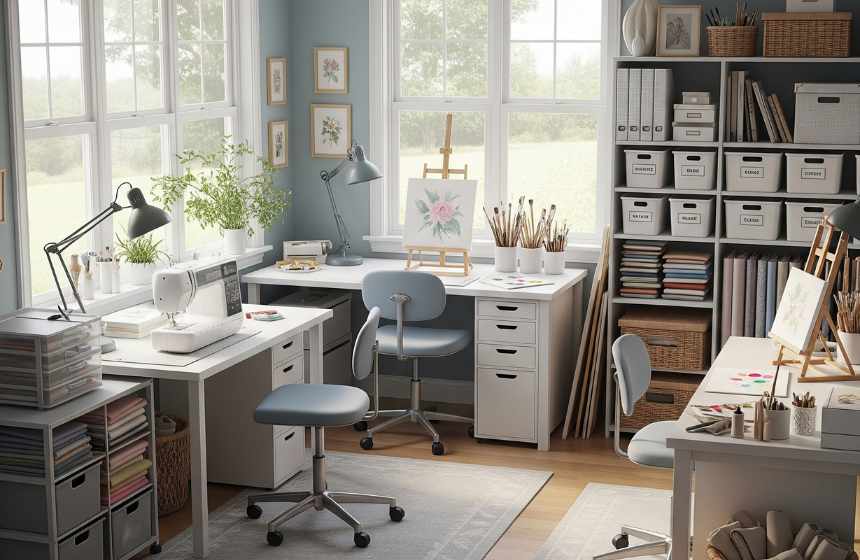
To create that layout, examine your space—measure dimensions and note natural light sources for workstations’ optimum positions.
Researching from Home Organization Magazine (in print and online, 2024) shows that crafters that create dedicated zones-an example is a sewing area, another is a paint area, and still another a storage area-nearly improve productivity by 40%.
Invest in ergonomics-choose adjustable seating and table heights for optimum prevention of strain during long sessions of crafting. Supposedly, work surfaces ranging between 28-30 inches are recommended for seated tasks that serve as an excellent standard.
Lay out smooth passageways, ensuring 36 inches between stations, to allow easy movement with supplies “interior designers refer to the kitchen work triangle for craft rooms” meaning to have tools stored within arms reach for crafting.
Also Read: 12 Aesthetic Room Decor Ideas Trending in 2025
2. Furniture Your Craft Ideal Space Addition.
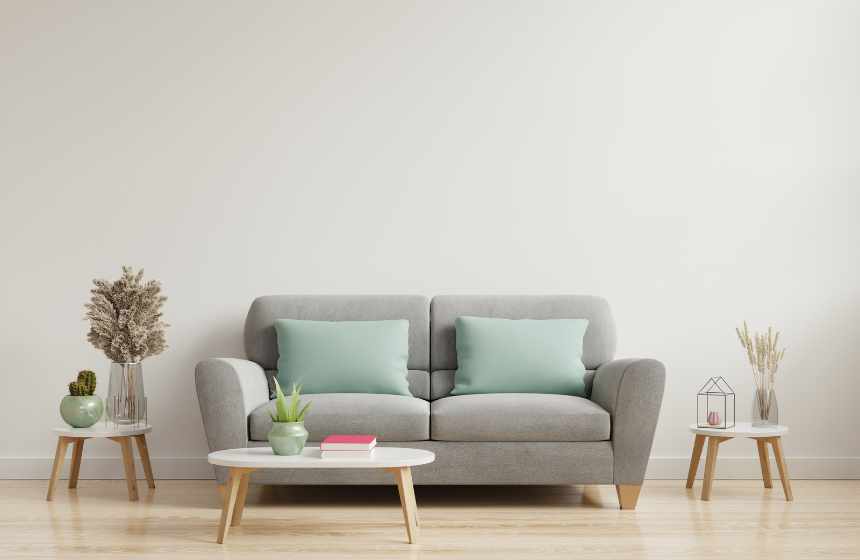
The right furniture makes the difference between a craft room that is messy and unkempt and one that is actually functional by giving way to versatility. Smaller spaces can have desks that are multi-purpose foldable, or made in a modular way.
A feature work surface is available in almost every size. Storage solutions are pegboard that keeps searching and finding simple for tools and rolling carts for mobility in shared spaces—that is, professional organizers say 40% less stress from clutter by the kinds of feature they create.
Display shelves serve double duty of organizing supplies while showing also inspirational completed projects. It’s said that DIY enthusiasts who use vertical storage were able to finish their projects 25% faster, according to the 2024 IKEA Living Report.
Invest in ergonomic chairs and adjustable-height tables for those long hours spent at the desk to avoid straining your back–that’s what the OSHA’s ergonomics guidelines would suggest for one working from home.
Also Read: Top 10 Boho Living Room Decor Ideas for a Cozy Home
3. Creative Decor Ideas Color psychology
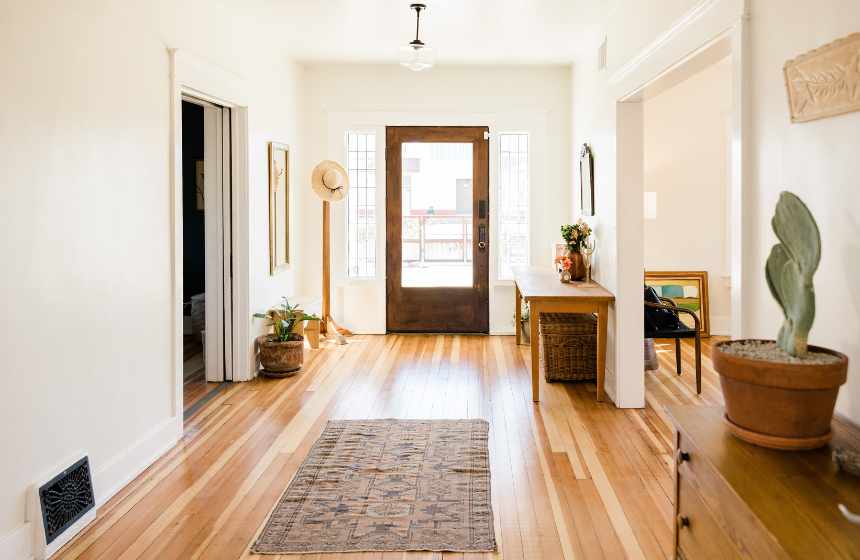
According to Sherwin-Williams’ 2025 Color Trends report, a softer blue will enhance one’s focus, while that stimulating yellow draws energy and enthusiasm.
Consider brightening up the walls with framed craft supplies, chalkboard walls, etc.; such visits would make a space 30% more utilized, according to Pinterest data.
Layered lighting is extremely crucial where LED strips illuminate specific detailed tasks while pendant lights create ambiance. Proper lighting reduces eye fatigue by 60%, according to a survey over at the University of Texas.
Infuse some DIY themes like “bohemian maker space” or “modern minimalist studio,” included through getting them in with textiles and accent walls. Snake plants, for example, according to NASA’s Clean Air Study, are major air purifiers and help boost mood.
Also Read: 12 Brown Decor Living Room Ideas
4. Cost-Friendly DIY Projects
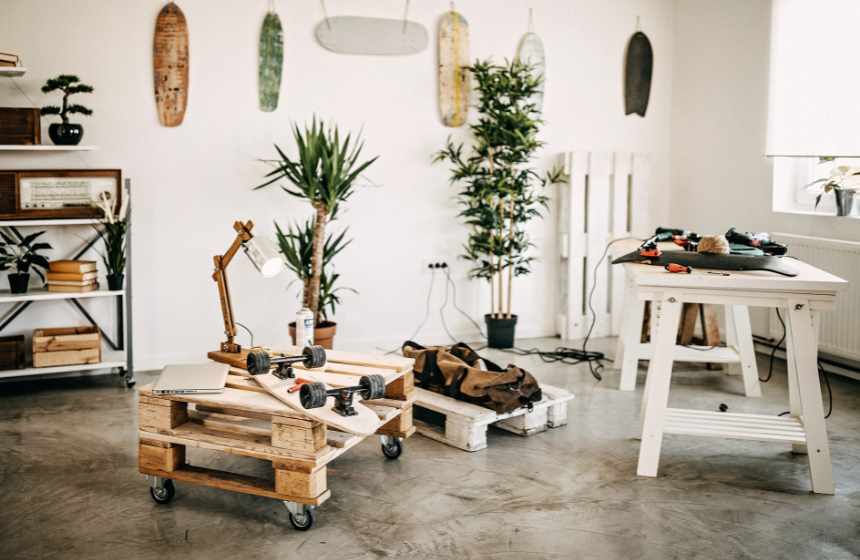
For instance, mason jars can keep brushes organized, and pallet wood shelves give nice rustic warmth for under $10. DIY peg boards, which are made using dollar store hooks and thus can be customized, are about 80 percent less expensive than what is available in stores, DIY Network says.
Secondhand furniture such as dressers converted into fabric storage units cuts value while adding character, as Facebook Marketplace saw a 50 percent increase in DIY craft-room upcycling projects since 2023.
Use an old baking sheet as magnetic holders for small metal tools-a hack that has earned applause from Martha Stewart Living. These shows are testimony that style needs creativity and basic tools, not necessarily large budgets.
Also Read: Home Decor Ideas for a Stylish Living Room and Kitchen
5. Supplies Organized Like a Pro

Be organized strategically for an efficient workflow. Items that are not for daily use will go in caddies or drawer dividers, and things like scissors and glue guns will be easy to access in caddies under drawers.
Whether incorporating a labeling system such as color-coded bins or QR code tags (which is a trend expected to see a 65% rise in 2025 as per Container Store sources), saves you hours in searching.
Make Use of Space Save Space by having over-door organizers for ribbons or rafters mounted from the ceiling for heavy materials such as canvases.
The Home Edit Professionals note that having “zones” set in a crafter’s area-referred to as paper station, painting corner-decreases cleanup by half.
Audit Supplies Regularly-once in every quarter, unearthed non-usage supplies to give way for something needed or something new in the space.
Also Read: 12 Best Home Decor Products for Living Room
6. Live Inspiration
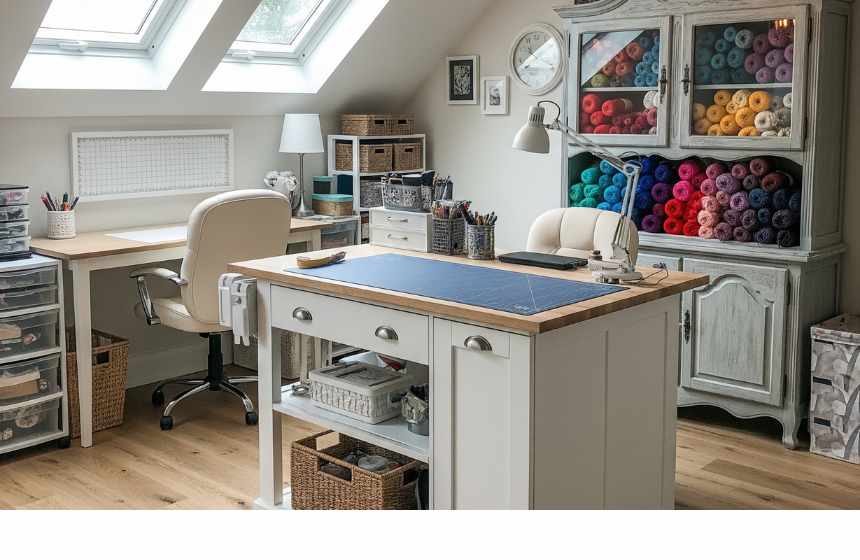
Further proof that small spaces can shine. Luxury studios from HGTV tours highlight professional-grade islands fitted with built-in cutting mats.
The hashtag Craft Room Goals has over 120,000 DIY solutions on Instagram, from upcycled china cabinets that hold yarn to attic studios that boast skylight lighting.
According to a Houzz survey conducted in 2025, 70% of the crafters revamped their spaces after these tours, with equal focus on aesthetics and a smooth workflow.
Also Read: 10 Budget-Friendly Furniture Pieces For Home Decor
7. Maintenance Tips
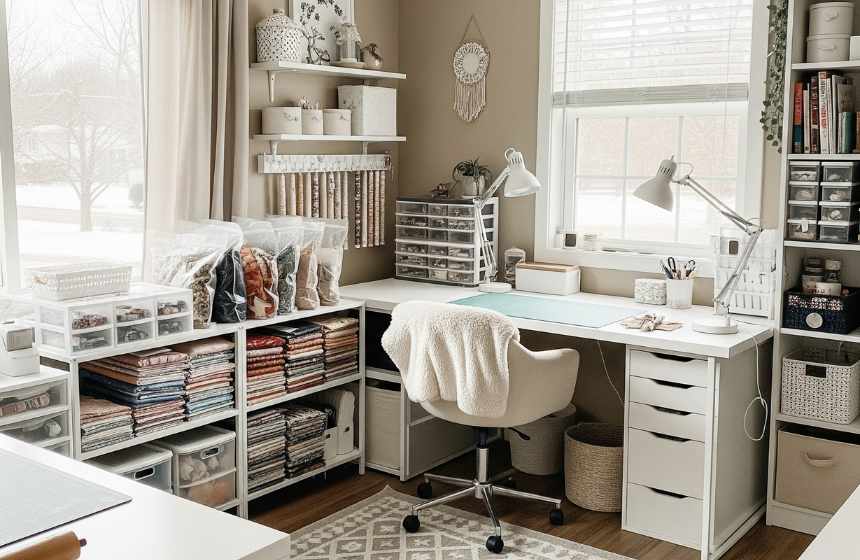
Therefore, we suggest adopting a short nightly tidying routine, one that Kondo herself used in her own creative spaces, so the mess never becomes overwhelming.
Seasonal changes—such as taking away summer’s bright linens and replacing them with soft textures for winter—freshen up inspiration; Real Simple states that this habit can increase room utilization by 45% in the long haul.
For the sake of your materials, wipe down surfaces weekly with a microfiber cloth to remove dust buildup; store seasonal fabrics in clear vacuum-seal bags to prevent mildew, a tip passed down from archival conservators at The Smithsonian.
And finally, once every year, take time to renew the space by revisiting layouts that resonate with the needs of your crafting as they evolve.
Also Read: 12 Evergreen Kitchen Wall Decor Ideas to Refresh Your Space.
Conclusion
Even though it is a place where one works, craft rooms also must inspire creativity and activate productivity while adding your own uniqueness as the individual crafting there.
Smart layouts, an ergonomic furniture system, DIY projects on the budget, and pro-organizational tips capture most of these expert ideas in constructing a functional and beautiful haven for crafting.
These ideas will assist you whether you are redoing that corner of your own or an entire studio. Keep in mind that many of the best spaces evolve with the needs of the occupant, so get inspired by real-life craft room tours, make it easy for maintenance, and most importantly, make it your own.
Now grab those tools and spark your imagination. Now, let’s make the ultimate craftroom into an ultimate creative stay. Happy crafting!
FAQs
1. How am I decorating a craft room within a budget?
To decorate a craft room on a budget use repurposed furniture, DIY storage, and thrifted finds. Use dollar store bins, mason jars, or upcycled shoeboxes for supplies.
Paint with budget-friendly chalkboard or pegboard to make walls functional, functional, and decorative at the same time. Thrifted shelves and Ikea cubbies, such as Kallax, offer stylish storage, while vintage tins or piano roll boxes can give the charm.
Hang up free vintage printables or fabric scraps for wall art. Prioritize multi-purpose items like rolling carts to get the most out of budget.
2. What sort of illumination is best for a craft room?
Ideal lighting in craft rooms combines ambient and task light sources. The latter type dimmable LED bedside table lamps, or gooseneck lighting fixtures minimize shadowing when performing fine detail work.
A light ring suffices for even bright diffuse light sources during the glare, while supporting clamp-on magnifying lights perform precision tasks. Natural daylight would suffice, but supplemented with daylight bulbs (5000K-6500K) to mitigate eye-strain caused by work.
Ambient lighting effects from BlissLights projectors or string lights could really assist in any craft-tool room getting mood lighting to boost those creative juices. Warm bulbs have to be avoided because they may distort colors.
3. How do you organize a small craft room?
Utilize overhead vertical spaces through wall-mount, pegboard, slatwall, or floating shelf installations. Include stackable drawers, rolling carts, and foldable tables for flexible layout design.
Using clear bins, labeling jars, hanging over-door organizers, or shoe cubbies will maximize otherwise wasted space. Consider separating zones according to activity type, such as sewing, painting, etc. and have regular declutter on the spaces to keep them organized. Small closets can be converted to craft corners by adjustable shelves.
Recent Posts
Rise of Spa-Like Wellness Retreats in Modern Bathroom Design
Modern residences have changed into multi-functional areas that not only provide a living environment but also a spa-like wellness. The most visible change in this trend is bathroom design, where the...
Maximize Your Mini Bathroom: Clever Remodeling Tips & Stylish Designs
In the domain of home design, the mini bathroom has always been regarded as a problem—a space that is small and functional only with minimum potential. This notion, however, is ignoring a...
